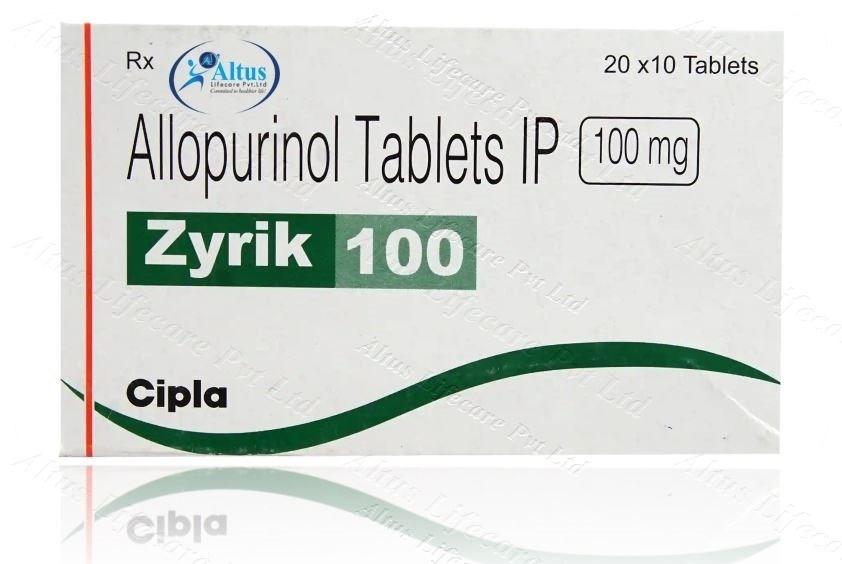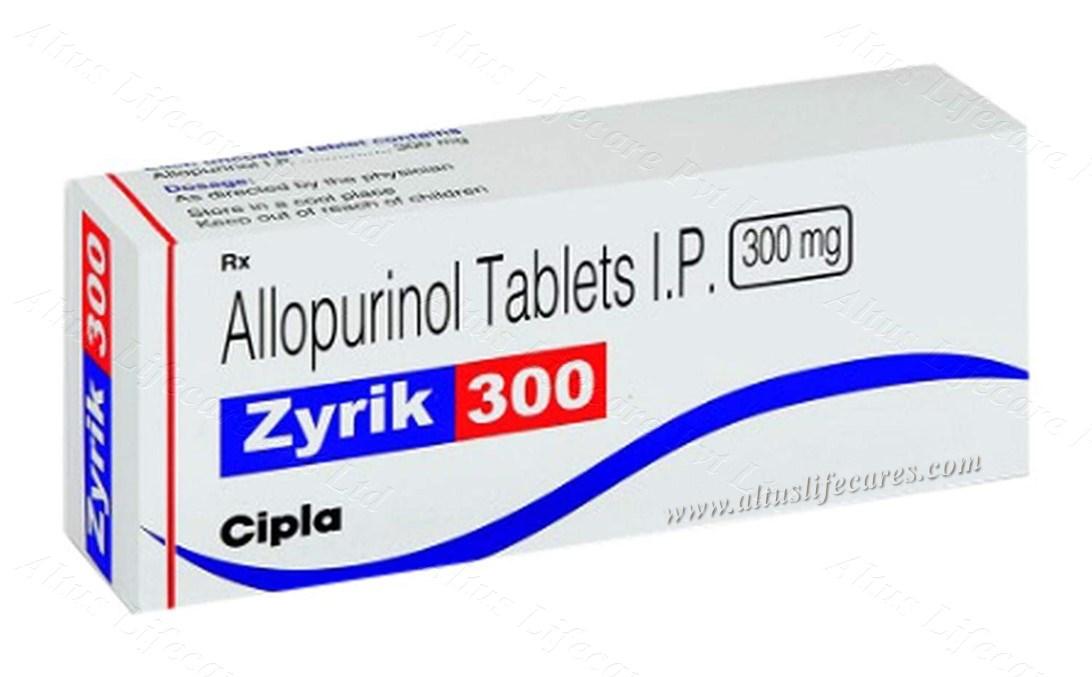Allopurinol Tablets: The Gold Standard in Gout and Uric Acid Management

Quick Summary: A Game-Changer for Gout and More
In the realm of chronic conditions such as gout and hyperuricemia, Allopurinol Tablets stand out as a time-tested, reliable, and effective therapeutic solution. This remarkable medication has helped millions of individuals around the globe reclaim a better quality of life by managing their uric acid levels with precision and long-term efficacy. With consistent results, a well-understood safety profile, and cost-effective availability, Allopurinol remains the frontline therapy in a doctor's arsenal against urate-related disorders.
What makes Allopurinol particularly valuable is its ability to not only treat but also prevent the recurrence of gouty episodes, kidney stones, and complications from high uric acid. Whether used alone or in combination with lifestyle interventions, Allopurinol offers comprehensive care for chronic urate issues. This blog explores every aspect of this pharmaceutical marvel in depth — from its mechanism of action and benefits to side effects, dosage, patient experience, and beyond.

📑 Table of Contents
- Introduction to Allopurinol Tablets
- What is Allopurinol?
- Composition and Available Strengths
- Mechanism of Action: How It Works
- Key Medical Uses and Indications
- Dosage Guidelines and Administration
- Benefits of Allopurinol Tablets
- Side Effects and Risk Management
- Drug Interactions and Precautions
- Patient Experience and Real-World Results
- Allopurinol vs. Other Uric Acid-Lowering Agents
- Storage, Handling, and Availability
- Who Should Avoid Allopurinol?
- Why Physicians Trust Allopurinol
- Long-Term Use: Safety and Efficacy
- Clinical Trials and Research Insights
- Enhanced Quality of Life with Allopurinol
- Final Take: A Therapeutic Ally for Life
- FAQs About Allopurinol Tablets
1. Introduction to Allopurinol Tablets
Allopurinol Tablets are an essential oral medication widely prescribed for managing hyperuricemia, especially in patients suffering from gout, kidney stones, or uric acid complications from cancer treatments. It is recognized globally as the first-line xanthine oxidase inhibitor and continues to demonstrate consistent clinical performance across various demographics.
2. What is Allopurinol?
Allopurinol is a purine analog that inhibits the activity of xanthine oxidase, the enzyme responsible for converting hypoxanthine and xanthine into uric acid. By reducing the production of uric acid, Allopurinol lowers serum and urinary urate levels. This makes it highly effective in treating conditions triggered by elevated uric acid, such as gout and certain types of kidney stones.
3. Composition and Available Strengths
Allopurinol Tablets are available in multiple strengths, typically:
- 100 mg
- 300 mg
Each tablet contains the active ingredient Allopurinol along with standard pharmaceutical excipients. The variety of strengths allows physicians to tailor the dose according to the severity of the patient's condition and renal function status.
4. Mechanism of Action: How It Works
The therapeutic power of Allopurinol Tablets lies in their elegantly precise and scientifically grounded mechanism of action. Rather than offering temporary relief or masking symptoms, Allopurinol targets the root cause of uric acid disorders at the biochemical level, setting it apart from most symptomatic treatments.
Understanding the Urate Production Pathway
To fully appreciate how Allopurinol works, it is essential to understand the uric acid production pathway in the human body:
- The body constantly breaks down purines, which are naturally occurring substances found in certain foods (like organ meats, seafood, and alcohol) and are also released from dying cells.
- During this breakdown, purines are metabolized into hypoxanthine, which is then converted into xanthine.
- Finally, xanthine oxidase, an enzyme in the liver and intestines, catalyzes the conversion of xanthine into uric acid, a waste product normally excreted by the kidneys.
However, in people with hyperuricemia or gout, this process results in the overproduction or under-excretion of uric acid, leading to crystal deposition in joints, kidneys, and tissues — a painful and often debilitating scenario.
The Dual Action of Allopurinol
Here’s where Allopurinol comes in as a true game-changer. It doesn't simply flush uric acid out; instead, it prevents its formation at the source by inhibiting xanthine oxidase. This dual action is crucial for both treatment and long-term prevention.
- Enzyme Inhibition: Allopurinol is structurally similar to hypoxanthine, allowing it to act as a competitive inhibitor of xanthine oxidase. Once ingested, Allopurinol is metabolized into its active form, oxypurinol, which binds tightly to the enzyme’s active site and blocks its function.
- Reduction in Uric Acid Synthesis: By preventing xanthine oxidase from converting hypoxanthine and xanthine into uric acid, the production of uric acid drops significantly — both in serum and in urine. This results in a lower concentration of urate in the bloodstream, thus reducing the likelihood of crystal formation in joints and tissues.
- Increase in Soluble Metabolites: At the same time, the levels of hypoxanthine and xanthine rise slightly. However, these intermediates are more water-soluble than uric acid and can be easily excreted through urine without forming crystals, thereby minimizing the risk of nephrolithiasis or tophus buildup.
A Preventive Shield Against Complications
One of the most powerful aspects of Allopurinol’s mechanism is that it prevents complications before they even begin. By consistently lowering serum urate levels, Allopurinol:
- Prevents future gout attacks
- Dissolves existing tophi over time
- Protects kidney function by reducing the risk of stone formation
- Prevents tumor lysis syndrome (TLS) in cancer patients undergoing chemotherapy, where sudden cell breakdown releases large quantities of purines
This preventive function elevates Allopurinol from a symptomatic treatment to a disease-modifying agent.
Long-Lasting Impact Through Metabolite Activity
The effect of Allopurinol doesn’t vanish quickly after ingestion. Its active metabolite, oxypurinol, has a long half-life, allowing for once-daily dosing in most patients. This provides:
- Sustained enzyme inhibition
- Stable uric acid levels throughout the day
- Improved treatment adherence due to convenient dosing
Renal-Sparing Mechanism
Unlike uricosuric agents such as Probenecid, which enhance uric acid excretion and can strain the kidneys, Allopurinol’s mode of action is independent of renal excretion pathways. This makes it a preferred choice for patients with mild-to-moderate renal impairment.
In Summary: Why This Mechanism Matters
To summarize, Allopurinol offers a scientifically robust and clinically validated approach to controlling uric acid levels through:
✅ Inhibition of xanthine oxidase
✅ Reduction of uric acid synthesis at the source
✅ Promotion of water-soluble, easily excreted purine metabolites
✅ Sustained efficacy due to its active metabolite
✅ Applicability across a wide patient population — including those with kidney disease and cancer-related hyperuricemia
By targeting the very heart of purine metabolism, Allopurinol represents a mechanistic triumph in uric acid management — and that’s precisely why it remains a mainstay in treatment protocols worldwide.
5. Key Medical Uses and Indications
Allopurinol is most commonly indicated for:
- Gouty arthritis
- Chronic tophaceous gout
- Uric acid nephrolithiasis (kidney stones)
- Hyperuricemia secondary to chemotherapy or radiotherapy
- Prevention of uric acid nephropathy in tumor lysis syndrome
Its broad utility across conditions related to uric acid makes it indispensable in both rheumatology and oncology settings.
6. Dosage Guidelines and Administration
The dosing of Allopurinol is highly patient-specific. General guidelines are:
- Initial dose: 100 mg daily
- Titrated dose: Gradually increased based on serum urate levels (up to 300–600 mg daily)
- Pediatric use: Dosed based on body weight for specific indications
Patients are advised to take the tablets after meals to reduce gastrointestinal discomfort and to maintain adequate hydration throughout the day.
7. Benefits of Allopurinol Tablets
The advantages of Allopurinol are vast:
- Prevents painful gout flares
- Reduces urate crystal deposition
- Decreases kidney stone recurrence
- Improves quality of life
- Minimizes long-term joint damage
- Can be used in cancer patients to prevent uric acid overload
Additionally, it is affordable, well-studied, and readily available, making it a go-to medication in both urban and rural healthcare setups.
8. Side Effects and Risk Management
Like any medication, Allopurinol may present side effects, although most are mild and manageable:
Common Side Effects:
- Rash
- Nausea
- Diarrhea
- Headache
Rare but Serious Side Effects:
- Stevens-Johnson Syndrome (SJS)
- Toxic epidermal necrolysis (TEN)
- Liver enzyme elevations
- Hypersensitivity reactions
To mitigate risks, doctors often recommend starting with a low dose and monitoring liver and renal function periodically. Genetic testing (HLA-B*5801 allele) is recommended for high-risk populations (e.g., Han Chinese, Thai, Korean) to predict hypersensitivity risk.
9. Drug Interactions and Precautions
Allopurinol interacts with several other medications:
- Azathioprine and Mercaptopurine: Requires dose reduction due to increased toxicity risk
- Theophylline: Enhanced levels when taken with Allopurinol
- Ampicillin/Amoxicillin: May increase skin rash risk
It’s critical for patients to share their full medication list with their physician before starting therapy.
10. Patient Experience and Real-World Results
Patients on Allopurinol often report:
- Drastic reduction in gout attacks
- Increased mobility and pain relief
- Improved kidney function over time
- Greater satisfaction and compliance
In long-term use, Allopurinol is often praised for its predictable action and tolerability, helping patients stay consistent with treatment.
11. Allopurinol vs. Other Uric Acid-Lowering Agents
Compared to alternatives like Febuxostat or Probenecid, Allopurinol:
✅ Has a longer track record
✅ Is more cost-effective
✅ Is better for renal-compromised patients
✅ Offers greater dosage flexibility
While Febuxostat is a newer agent, current guidelines still position Allopurinol as first-line therapy due to its safety profile and affordability.
12. Storage, Handling, and Availability
Allopurinol Tablets should be:
- Stored at room temperature (15°C–30°C)
- Kept away from moisture and direct light
- Secured in a childproof container
They are available through most pharmacies under various brand names and generic labels, making them widely accessible.
13. Who Should Avoid Allopurinol?
Despite its benefits, certain patients should approach Allopurinol with caution or avoid it:
- Individuals with known hypersensitivity
- Patients with acute gout flare (use cautiously)
- Pregnant or breastfeeding women (only if prescribed)
- HLA-B*5801 positive individuals in high-risk groups
Proper screening and physician consultation can prevent most adverse outcomes.
14. Why Physicians Trust Allopurinol
Doctors choose Allopurinol because it is:
- Clinically reliable
- Well-researched
- Safe for long-term use
- Easy to titrate
- Cost-friendly
It continues to be a staple in treatment guidelines by the American College of Rheumatology (ACR) and EULAR for gout management.
15. Long-Term Use: Safety and Efficacy
Allopurinol is uniquely suited for lifelong uric acid control. Long-term studies demonstrate:
- Sustained urate lowering
- Fewer flares and complications
- Improved renal and joint outcomes
- Low cumulative toxicity
It is rare to find a medication that delivers both efficacy and endurance like Allopurinol.
16. Clinical Trials and Research Insights
Decades of research support Allopurinol’s superiority. Clinical trials have shown:
- Up to 90% urate reduction in compliant patients
- Significantly fewer gout attacks within 6 months
- Effective prophylaxis against tumor lysis syndrome
- No significant increase in cardiovascular mortality
The research community continues to endorse Allopurinol Tablets as a mainstay for urate-lowering therapy.
17. Enhanced Quality of Life with Allopurinol Tablets
Ultimately, Allopurinol does more than just reduce uric acid. It:
- Restores physical functionality
- Minimizes joint deformities
- Prevents renal complications
- Enhances mental well-being by reducing chronic pain and uncertainty
For many patients, it is not just a pill — it is a path back to normalcy.
18. Final Take: A Therapeutic Ally for Life
Allopurinol Tablets have withstood the test of time. In an era where medical advancements are constant, this classic yet powerful agent remains relevant, trusted, and indispensable. It empowers both doctors and patients to manage uric acid-related conditions with confidence and ease.
Its wide availability, long-standing safety profile, and proven benefits make Allopurinol Tablets not just a treatment — but a true therapeutic partner for life.
19. Frequently Asked Questions (FAQ)
Q1. Can I take Allopurinol Tablets during a gout attack?
It’s best to start Allopurinol Tablets after the attack subsides. Starting it during an active flare can worsen symptoms temporarily.
Q2. How long does it take for Allopurinol Tablets to show results?
You may notice improvements in uric acid levels within 1–2 weeks, but full control often takes 2–6 months of consistent use.
Q3. Is it safe to use Allopurinol Tablets for years?
Yes. Allopurinol is safe for long-term use under medical supervision, with regular monitoring of liver and kidney functions.
Q4. Do I need to follow a specific diet while on Allopurinol Tablets?
Yes, a low-purine diet can enhance the effectiveness of the medication. Avoid foods like red meat, shellfish, and alcohol.
Q5. Can I stop taking Allopurinol Tablets if my uric acid levels are normal?
No. Discontinuing without a doctor’s approval can cause uric acid to rebound. It’s usually a lifelong therapy for chronic conditions.
Q6. What should I do if I miss a dose?
Take it as soon as you remember. If it’s almost time for your next dose, skip the missed one. Do not double-dose.
Q7. Is Allopurinol Tablets safe during pregnancy?
Allopurinol should only be used during pregnancy if absolutely necessary and prescribed by your doctor.
Buy Online from: Allopurinol Tablets - Altus Lifecare Pvt Ltd
Zyrik Tablet (Allopurinol 100mg / 300mg) - Altus Lifecare Pvt Ltd
Zyrolic Tablet (Allopurinol 100mg / 300mg) - Altus Lifecare Pvt Ltd
- Art
- Causes
- Crafts
- Dance
- Drinks
- Film
- Fitness
- Food
- Jocuri
- Gardening
- Health
- Home
- Literature
- Music
- Networking
- Alte
- Party
- Religion
- Shopping
- Sports
- Theater
- Wellness
